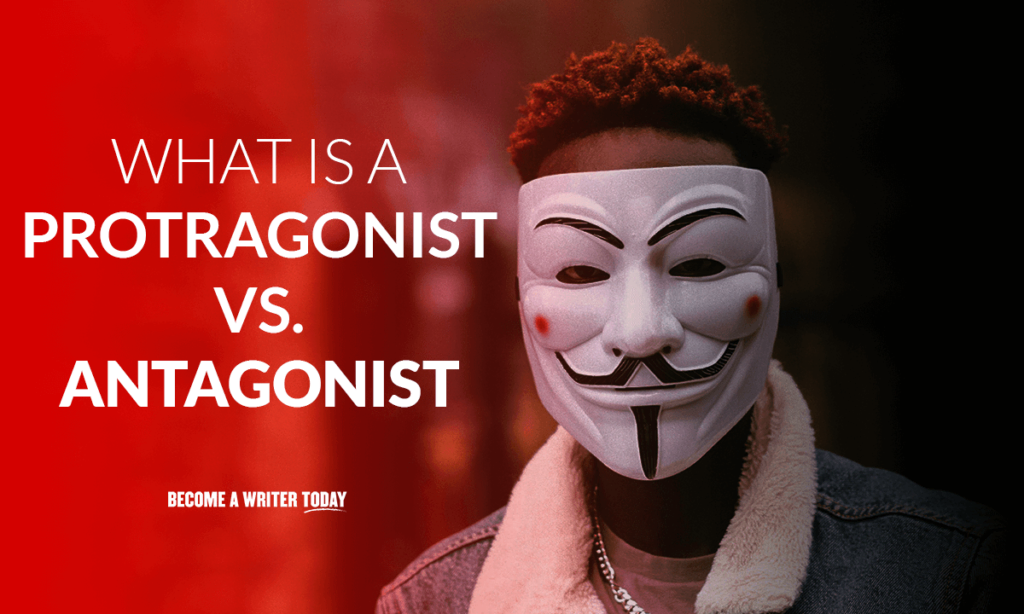Understanding the conflict between a protagonist vs antagonist is vital to writing strong fiction, and this guide will help.
Every story has a protagonist and antagonist, but understanding their differences can be tricky! When writing your story, you’ll need to choose a main character for your readers to root for and a secondary character. Typically, they are the “good” character – the protagonist and the “bad” character – the antagonist. If you’re an aspiring writer who dreams of selling self-published books, you’ll need to master the difference between these two characters.
We all know that every “good” character needs a rival to add some conflict and interest to the story; this is where the antagonist steps in. Building these two characters is vital to story building and character development; this technique is what makes the books by the best fantasy authors so engrossing.
Having both the “good” and the “bad” challenging each other throughout the story gives readers a key look at the true personality of these characters. It allows them to form their own opinions on whether or not they are rooting for the protagonist as the plot unfolds.
Contents
- What Is a Protagonist?
- Antagonist vs. Protagonist: Key Differences
- Types of Protagonists
- Protagonist Examples
- How to Create a Powerful Protagonist
- What Is An Antagonist?
- Types of Antagonists
- The Villain
- Conflict-Creators
- Inanimate Forces
- The Protagonist
- Antagonist Examples
- How to Write a Convincing Antagonist
- FAQs About Protagonist vs Antagonist
What Is a Protagonist?

In literature, the protagonist is the main character of the story. While they’re usually the “good” characters, a story can have a protagonist who is not morally good. In Ancient Greek, “protagonist” means “one who plays the first part.” The protagonist drives the story’s action, and the story arc usually aligns with the protagonist’s goals.
Antagonist vs. Protagonist: Key Differences
Some key differences can help identify your story’s antagonist and protagonist. The protagonist is the character the story is pushing toward success; as the reader reads the story, their thinking will be “pro” the protagonist.
The antagonist is the character who brings conflict to the story. Their goal is to antagonize the protagonist, making it easy to recognize the story’s “antagonist.” Remember this tip when differentiating between the two characters.
Types of Protagonists
Heroic Protagonist

The heroic protagonist is the traditional style of the protagonist. This type is the favorite of Disney movies and rags-to-riches stories. These protagonists have the perseverance to overcome tremendous odds, and the story may even come from their point of view. Even if someone else narrates the story, the main character arc is about the hero or heroine overcoming conflict to achieve their goal. Luke Skywalker from Star Wars and Frodo from The Lord of the Rings are both examples of heroes. Learn about movies that follow the hero’s journey.
Antihero
The antihero is a protagonist that has many flaws and may not be a virtuous individual. However, the story is about that person and their motivations and journey. They are the protagonists. They cannot be called a hero because they do not have the heroic, good-guy persona, but they are the main person in the story. Moby Dick’s Captain Ahab is an excellent example of an antihero.
Villainous Protagonist
The villainous protagonist, sometimes linked with the antihero category, is the villain or bad guy in the story, yet they are also the central character. Sometimes books and movies will explore the motivation and actions of a villain, and they become the center of the storyline. The Grinch from How the Grinch Stole Christmas exemplifies this type of protagonist.
False Protagonist
Technically, the false protagonist is not a true protagonist. This character appears to be the story’s most important character at the beginning. The author will spend a lot of time exploring this person’s backstory and motivations, only to kill them and reveal the true protagonist. This jarring change grabs the reader’s attention and makes them notice what the author is doing. Marion Crane in the Hitchcock film Psycho is the most common example of a false protagonist.
Protagonist Examples
To better understand these types of protagonists, consider these classic examples:
Hero Protagonist
- Harry and his friends in Harry Potter
- Luke Skywalker from Star Wars
- Katniss Everdeen from The Hunger Games
Antihero Severus
- Snape in Harry Potter
- Robin Hood in Robin Hood
- The Whale in Moby Dick
False Protagonist
- Ned Stark in Game of Thrones
- Marion Crane in Psycho
- Bernard Marx in Brave New World
How to Create a Powerful Protagonist
To create a strong story, you need a strong protagonist! Take time to develop your character. Learning from some of the greatest writers might be helpful by taking a course. Check out our Neil Gaiman MasterClass review. Remember, readers need to connect to the protagonist emotionally, and someone who takes too high of a moral ground may be hard to connect with.
To write strong protagonists, start by first developing the human character. Make them have both strengths and weaknesses that play into the story. Give them human flaws that help readers relate to them, then create a story that lets them grow and change as the story unfolds.
A good story must have an important character who risks something to achieve a goal.
What Is An Antagonist?
On the other side, the antagonist is the character who fights against the protagonist. Usually, the antagonist’s goal is to stop the protagonist from achieving their goals. This comes from the Greek word “antagonistes,” which means “chief foe.”
You can have a group of antagonists or just one character in your story, depending on the author’s goal. Sometimes the antagonist can be a circumstance or an inanimate force, but usually, it’s a character.
Types of Antagonists
To better understand these types of antagonists, consider these helpful examples:
The Villain
The villain is your quintessential “bad” character in a story. This evil character is the main source of conflict against the main character or group of characters. Some classic examples of villains include Voldemort from Harry Potter, any evil witches from a classic fairy tale, and Darth Vader from Star Wars.
Conflict-Creators
Conflict-creators as antagonists are not necessarily evil. They may not have the best intentions, but they are not bad at their core. However, they do work against the antagonist because their goal is conflict. Mr. Darcy from Pride and Prejudice is a good example of a conflict creator.
Inanimate Forces
Forces of nature or even government systems can be the protagonist in a story. These are not people but rather inanimate objects. In The Hunger Games, the government system and the games themselves are the main antagonists, even though President Snow is the human face of those groups. The sea in Robinson Crusoe is another example of an inanimate force as an antagonist.
The Protagonist
In some stories, the protagonist is the antagonist as well. If the person’s insecurities and human shortcomings are what keep them from achieving their goals, then they are the antagonist and the protagonist. The most often-cited example of this is Holden Caulfield from The Catcher in the Rye.
Antagonist Examples
To better understand these types of antagonists, take a look at these classic examples:
Villain
- Voldemort in Harry Potter
- The Wicked Witch of The West in The Wizard of Oz
- Darth Vader from Star Wars
- The Capitol from The Hunger Games
- Sauron from The Lord of the Rings
Conflict-Creator
- Javert in Les Miserables
- Mr. Darcy in Pride and Prejudice
Inanimate Forces
- The sea in Robinson Crusoe
- Time-traveling in The Time Traveler’s Wife
The Protagonist as an Antagonist
- Elizabeth’s prejudice in Pride and Prejudice
- Holden in The Catcher in the Rye
- The narrator himself in The Tell-Tale Heart
How to Write a Convincing Antagonist
It’s important to make the antagonist relatable to the reader by giving them some good qualities as well as bad ones. Villains often have a relatable and complex past that ultimately leads them to become evil.
Be careful not to give your antagonist too much or too little power. The villain needs to be challenging for the protagonist to overcome to make the stakes high in the story, but if the villain is all-powerful, the hero’s victory will feel unbelievable.
Remember to give your main antagonist some sort of backstory. This will help them feel more relatable and give you more interest in your writing. Read our guide on how to write a backstory to get started!
FAQs About Protagonist vs Antagonist
What is the difference between an antagonist and a protagonist?
In literature, a protagonist is the main character of the story. They may be good, but sometimes they are evil. The antagonist, in contrast, works against this main character to stop them from reaching their goal.
Can an antagonist be a protagonist?
It’s possible for a story to have a character that appears to be an antagonist, only to come out as the protagonist in the end. However, the opposite, a protagonist eventually revealed as an antagonist, is the more common structure.
Can the antagonist be the main character?
In some stories, the antagonist and the protagonist are the same people. The protagonist’s internal struggles send them on their journey, so they are both the protagonist and the antagonist. Similarly, some protagonists are the villains of their stories, and thus they appear to be antagonists.
Can a protagonist be a villain?
Yes, protagonists can be evil and can even become a villain. Villainous protagonists are less common than heroic ones, but they can be interesting in novels. In some books, a protagonist villain develops into a good person by the end of the story.
What is an example of an antagonist and protagonist?
Some of the most common examples can help you understand the difference between antagonist and protagonist. Voldemort in Harry Potter is a classic example of an antagonist, and Harry and his friends in Harry Potter are an example of a protagonist and a group of protagonists.
Is the antagonist the bad guy?
In a typical story, the antagonist is the “bad guy.” However, many stories contain antagonists that are not inherently evil and often develop into better people as time goes on.
Looking for more? Check out our guide on how to write a book!